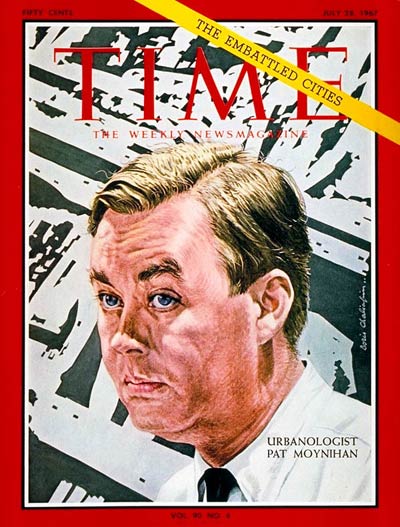
Milestone moments do not a year make. Often, it’s the smaller news stories that add up, gradually, to big history. With that in mind, in 2017 TIME History will revisit the entire year of 1967, week by week, as it was reported in the pages of TIME. Catch up on last week’s installment here.
It was an urgent question in 1967: What was happening to the American city? One person whose answers were gaining traction was Daniel Patrick Moynihan, whom TIME identified in a cover story as both the most controversial and most important figure in the growing field of urban studies. The future New York Senator was still known for the so-called Moynihan report, which in 1965 caused an uproar with its conclusion that the urban African-American family was falling apart as a social unit. Many responses “emphasized the report’s sensational findings about the family, often overlooking Moynihan’s analysis of the causes, notably centuries of discrimination and economic deprivation,” TIME noted, but he had now turned his eye to the cities themselves.
He wasn’t alone.
“Just as most of the problems besetting Americans grow out of the conditions of city life, so do most of the things that make the U.S. tick,” the magazine observed. “Fully 90% of the gross national product comes out of the cities; most of America’s ideas are thought up in the cities, most of the culture is centered there. Yet in a summer of racial wrath that has already shaken dozens of American cities, the problems of urban life suddenly seem all but insuperable.”
Moynihan’s conclusion was that an infusion of money, in many cases directly into the pockets of residents, was the best way to solve every other problem of the cities. Others suggested curbing car use so that neighborhoods would be reinvigorated by pedestrian traffic, and still others blamed the suburbs for depriving cities of an economic base and creating transportation boundaries that created what one historian called the “crabgrass curtain” between the two realms.
In some ways, the problems Moynihan and his colleagues sought to resolve have come even further than they could have ever hoped. Many American cities are extremely safe places, and concerns have white flight have given way to worries about gentrification in many urban areas. And yet, the divide between the cities and the rest of the nation remains as crucial an issue as ever.
Simmering: In the wake of rioting in Newark, N.J., it was clear that the issues that had caused conflagrations in more than two dozen American cities in 1967 were, in some ways, only getting worse. White Americans who didn’t live in cities watched the events from afar, their fear increasing, exacerbating the tension that was one part of the cause of the riots in the first place. And with each riot so far, pointed out one sociologist, the aftermath had been a tug-of-war between those who thought doing nothing was unfathomable and those who believed that trying to fix things was rewarding the rioters. Meanwhile, the summer had not yet reached its peak. (Also on this topic, the essay this week explores the role of violence in American society and history; it’s a striking look at the state of a nation that could simultaneously contain peace-loving hippies, race riots and wage the Vietnam War.)
Bills, bills, bills: Stop me if you’ve heard this one before. Medical costs in the U.S. were spiking, having ballooned by 42% in the prior decade, against a 19% overall rise in the consumer price index. In a story this week, TIME maps that increase and looks at what’s driving the spending.
Packing tips: With more Westerners traveling to the USSR as tourists, what should they pack? TIME’s advice: “Even in summer, the suitcase should contain warm as well as summer clothing, plenty of color film to be developed back in the U.S., a rubber sink stopper (many of the sinks are plugless), toilet paper (public washrooms don’t provide any), a small short-wave radio for picking up the BBC or Radio Free Europe (the only English-language sources of non-Party-lining news) and an assortment of gifts.”
Auto trends: The salad days of the convertible were officially ending, as in-car air conditioning replaced less predictable breezes.
Drug-store brand: In the business section, TIME went behind the scenes at Walgreen’s, in light of the chain’s fast-growing business. Of interest to today’s readers: the fascinating anecdote about how a venture into cosmetics and milk shakes helped shape the look of the American drug store, which by that point had already become something much more than a pharmacy.
Great vintage ad: Here’s a classic Volkswagen ad, showing that — for the price of a fancier car — you can buy a Beetle and a whole lot more.
Coming up next week: Riots, again
More Must-Reads from TIME
- Donald Trump Is TIME's 2024 Person of the Year
- Why We Chose Trump as Person of the Year
- Is Intermittent Fasting Good or Bad for You?
- The 100 Must-Read Books of 2024
- The 20 Best Christmas TV Episodes
- Column: If Optimism Feels Ridiculous Now, Try Hope
- The Future of Climate Action Is Trade Policy
- Merle Bombardieri Is Helping People Make the Baby Decision
Write to Lily Rothman at lily.rothman@time.com